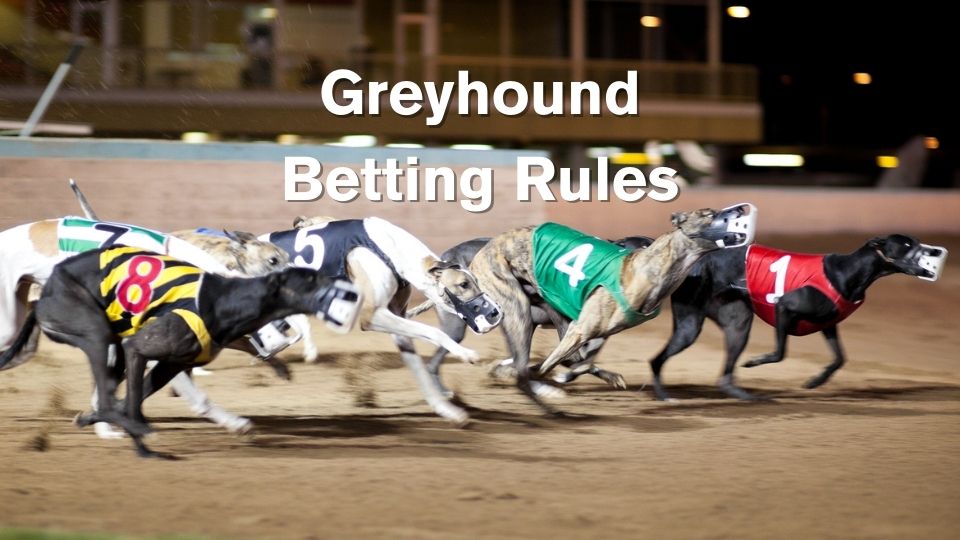Greyhound racing is a sport that values speed above all else. The guiding concept, “The fastest dog wins”, is an easy-to-understand rule of thumb. However, beyond this basic principle lie various nuances that form the backbone of the sport. These nuances can influence a dog’s performance on the racetrack, thereby having potential effects on betting outcomes.
Greyhound Racing Betting Rules
Betting on greyhound races entails understanding of specific rules and guidelines. These rules serve to maintain a fair and structured wagering environment. For beginners and seasoned punters alike, understanding these rules is crucial for informed betting.
Each Way Betting Rules
In greyhound racing, an each way (E/W) bet is an additional wagering option that allows punters to hedge their bets by betting not only on a dog to win, but also one to finish in a specified number of places. Each way terms and the number of places paid vary depending on the number of dogs competing in a race and the bookmaker’s set rules. The following information serves as a general guide for E/W betting:
Number of dogs in a race and the corresponding E/W terms:
- Less than five runners: No each way terms offered
- 5-7 runners: First two places paid at 1/4 odds
- 8 or more runners: First three places paid at 1/5 odds
Payouts for each way bets are determined by the odds offered and the amount wagered. To help estimate potential returns, consider using an each way calculator, which can easily be found online through search engines.
To better understand how each way betting works, consider the following table comparing the E/W terms based on the number of dogs in a race:
| Number of Dogs in a Race | Each Way Terms Offered | Places Paid | Odds Offered |
|---|---|---|---|
| Less than five | None | N/A | N/A |
| 5-7 | First two places | 2 | 1/4 |
| 8 or more | First three places | 3 | 1/5 |
In conclusion, each way betting serves as a flexible option for punters to extend their betting strategies, potentially reducing risks and increasing opportunities for returns on their wagers.
Trap Betting Rules in Greyhound Racing
In greyhound racing, trap betting refers to wagering on the specific starting position, or trap, a dog will start from, rather than betting on a specific dog. This aspect of greyhound betting can present unique circumstances and rules for punters. Although the fundamental operation of this betting type is straightforward, complications may arise from exceptions such as non-participating dogs and substitutions.
Non-Runner Scenario
Non-participation by a dog in a specific trap number can influence the result of trap betting.
Rules regarding non-participation:
- When a dog declared as a non-runner leads to an empty trap number, such a situation is usually settled as a non-runner bet.
- In such cases, your stake is typically refunded, or the selection is scratched in the case of multiple bets.
Understanding these rules can help punters account for unexpected instances where the participating dog fails to run.
Reserve Replacement Scenario
Another unique situation occurs when a dog that does not run is replaced by a reserve dog.
Rules regarding reserve replacements:
- If your chosen trap number features a dog that doesn’t run, but a reserve dog replaces it, the outcome of your bet is usually based on the finishing position of this substitute greyhound.
This system allows punters to continue their trap bet, even in the event of the initially assigned greyhound’s non-participation.
To summarize, here is a table comparing the two potential scenarios in trap betting:
| Scenario | Effect on Trap Bet | Settlement |
|---|---|---|
| Non-Runner | Bet usually nullified | Stake is refunded or that portion of multiple bets is scratched |
| Reserve Dog Replacement | Bet remains valid | Bet usually settled based on the finishing position of the substitute dog |
In all cases, the specific rules may vary from bookmaker to bookmaker, and it’s always advisable to understand the house rules thoroughly before placing your bets.
Non-Runner Betting Rules in Greyhound Racing
Greyhound racing features a betting category known as non-runner betting, which provides rules and accommodations for the situations where a dog bet upon is declared a non-runner. A non-runner refers to a dog that has been withdrawn from a race after bets have been accepted.
Refund Rule for Non-Runners
Bookmakers traditionally refund the stake of punters when the specified dog is declared a non-runner. This practice has become standard across industry platforms.
Non-runner refund rules:
- In most cases when the chosen dog is declared a non-runner, the bookie will refund your stake.
- Even when a reserve dog takes over the place of the original dog selection, if the bet was placed on a specific runner and not just a trap number, it is typically still considered a non-runner bet.
These stipulations help ensure bettors aren’t at a considerable disadvantage when an unforeseen withdrawal occurs.
Adjustments for Starting Non-Runners
When a dog starts in a race affected by non-runners, there are changes to the initial odds offered.
The alteration in odds in the case of non-runners being present in a race:
- You will most likely be paid out at the new Starting Price (SP) rather than the odds you initially took.
This is specific to races where non-runners are a factor after bets have been placed.
To summarize these rules, the following table offers a quick comparison:
| Circumstance | Outcome |
|---|---|
| Dog declared non-runner | Refund of the stake |
| Reserve dog substitutes specific runner | Bet still treated as non-runner with refund applied |
| Non-runner affects race odds | Payout at new Starting Price (SP) rather than original odds |
These rules are part of the broader regulations that govern greyhound betting, adding layers of fairness and stability to the process. As always, the specific rules can vary somewhat from one bookmaker to another.
Trap Challenge Betting Rules in Greyhound Racing
Trap challenge betting is a distinct category within greyhound racing betting. In a trap challenge, punters bet on the trap that will have the most wins over a set number of races. As with any form of wager, understanding the specific rules surrounding this betting type is crucial in increasing the chances of success.
Impact of Non-Runners on Trap Challenge Bets
In trap challenge betting, non-runners present unique repercussions that differ from other forms of betting within greyhound racing.
Non-runner’s impact on trap challenge bet:
- When you bet on a specific trap number and a non-runner is declared from that trap in one race, your bet remains valid but unfulfilled for that race.
- As a result, you’ll lose in that specific race due to the lack of a contestant running from that trap.
These provisions ensure that trap challenge bets are resilient to changes in the race line-up after wagering has occurred.
Dead-Heat Scenario in Trap Challenge Bets
Another particularity of trap challenge betting revolves around situations where a dead heat occurs—when two or more dogs tie for the same rank.
Dead-heat rules in trap challenge bets:
- If a race is settled as a dead heat between two dogs and one of those dogs comes from your trap, you will earn half a point towards your trap challenge tally.
This allowance maintains the integrity of the scoring system, evenly distributing points when the exact ranks cannot be established.
Here’s a summarized comparison of the two special scenarios in trap challenge betting:
| Scenario | Impact on Trap Challenge Bet |
|---|---|
| Non-Runner | Loss of potential points from that particular race |
| Dead Heat | Half-point awarded if one of the dogs is from the selected trap |
Like all gambling practices, variations between bookmakers’ specific rules may arise. Therefore, punters are advised to thoroughly read and understand the house rules of each bookmaker before placing their bets.
Dead Heat Betting Rules in Greyhound Racing
Dead heat betting rules come into play when multiple dogs finish a race as winners, tying at the finish line. Recognizing the impact of dead heat scenarios on your payout is crucial to understanding the intricacies of greyhound racing betting.
Payout Calculation for Dead Heats
The payout calculation for dead heats adjusts your stake and final winnings based on the number of tied winners in the race.
Dead heat payout calculation:
- When your selected dog finishes as a winner in a dead heat, the bookmaker divides your stake by the total number of winning dogs involved in the dead heat.
- Your bet will be revised with the new stake and subsequently calculated at the original odds.
To illustrate this procedure, consider the following example:
- You bet £10 on a dog in trap 3 at 3/1 odds to win.
- The dog finishes in a dead heat with another dog from trap 4.
- There are now essentially two winners.
- The bookmaker divides your stake (£10) by the number of dogs involved in the dead heat (2).
- Your bet is revised as a £5 stake at 3/1 odds, yielding a total return of £20.
The table provided below gives an overview of dead heat payout calculations under various scenarios:
| Original Stake | Original Odds | Number of Dead Heat Winners | Revised Stake | Total Return |
|---|---|---|---|---|
| £10 | 3/1 | 2 | £5 | £20 |
| £10 | 5/2 | 3 | £3.33 | £16.65 |
| £10 | 7/1 | 3 | £3.33 | £26.64 |
| £20 | 2/1 | 4 | £5 | £15 |
Dead heat betting rules, like all aspects of gambling, can vary slightly between bookmakers. Thus, researching a bookmaker’s specific rules before placing bets can help to avoid any issues or misunderstandings during the payout process.
Abandoned Race Betting Rules in Greyhound Racing
Even in a sport as resilient as greyhound racing, sometimes inclement weather conditions, logistic issues, or unforeseen circumstances can lead to the abandonment of a race. Understanding how abandoned races impact your bets is an essential component of sensible and informed betting.
Rescheduled Races and Your Bets
The fate of bets placed on abandoned races largely depends on whether the race will be rescheduled and if the original selection enters the updated race.
Rescheduled races and bet status:
- If a race is abandoned but rescheduled to a later time or date, all original bets stand. Meaning, your bet remains active on the rescheduled race.
- In the event that your selection is declared a non-runner in the rescheduled race, you should expect a refund following standard non-runner rules.
Yet, keep in mind, there are exceptions where certain bookmaker-specific rules apply.
Effects on Odds in the Event of Rescheduled Races
Sometimes bookmaker policies may deviate from the norm when it comes to odds on rescheduled races.
Policy on odds for rescheduled races:
- Some bookmakers may not honor the odds at which you initially placed your bet.
- Instead, your picks will be settled at the revised SP (starting price) odds.
This table provides a clear comparison of the impact of abandoned races on placed bets:
| Scenario | Impact on Bet | Impact on Odds |
|---|---|---|
| Race rescheduled, selection onward | Original bets stand | Under certain bookmakers, revised SP odds apply |
| Race rescheduled, selection dropped | Refund, as per non-runner rules | N/A |
As always, these rules are subject to minor variations depending on the specific bookmaker. Punters are advised to familiarize themselves with individual bookmaker policies on abandoned races for the smoothest betting experience.
Ante-Post Betting Rules in Greyhound Racing
Ante-Post betting, a quintessential concept for any seasoned gambler, denotes the practice of placing bets in advance of an event, be it the Greyhound Derby or any other meeting. In the context of greyhound racing, it becomes critical to understand ante-post rules, particularly with respect to selections not competing as expected.
Rules for Ante-Post Selections
Bookmakers each have a specific approach to handling ante-post selections especially when the betted dogs do not compete in the race. It’s important to understand these rules before engaging in the ante-post market.
Bookmaker rules for ante-post selections:
- Some bookmakers operate under the ‘no runner, no bet’ policy, refunding your stake if your betted greyhound does not compete.
- Other bookmakers may settle your bet as a loss if your selection does not participate in the race as anticipated.
For a clearer understanding of ante-post betting rules, the table below lays out the potential outcomes depending on the bookmaker’s regulations:
| Scenario | Bookmaker Policy | Impact on Bet |
|---|---|---|
| Ante-Post selection does not run | No runner, no bet | Stake refunded |
| Ante-Post selection does not run | Default Loss | Bet settled as a loss |
While ante-post betting can offer the allure of higher potential returns, it carries with it specific risks and variations in bookmaker policies. It’s crucial for gamblers to familiarise themselves with their bookmaker’s specific ante-post rules for a more calculated and informed betting experience.




